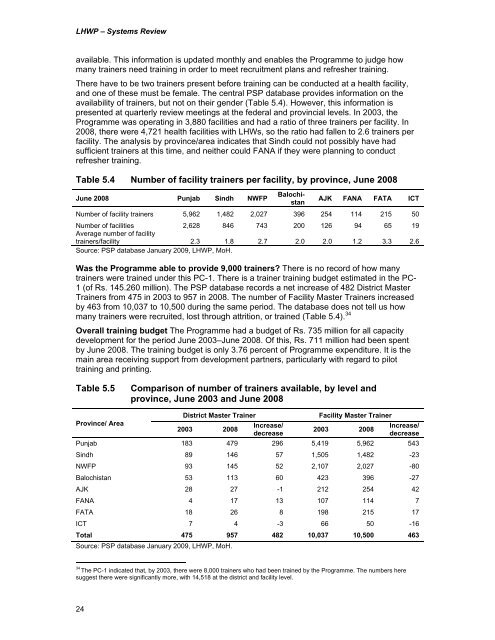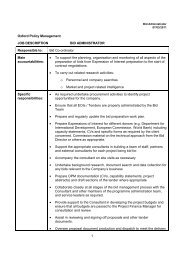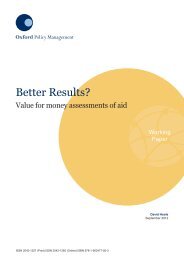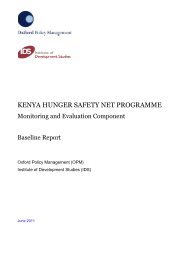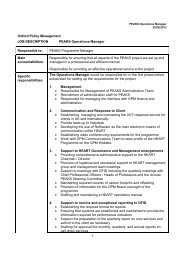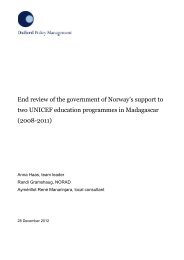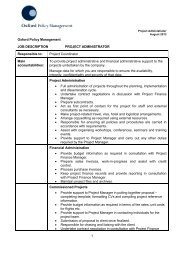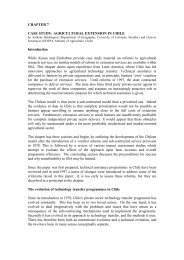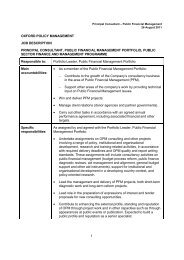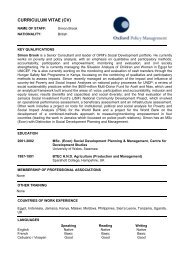<strong>LHW</strong>P – <strong>Systems</strong> <strong>Review</strong>available. This information is updated monthly and enables the Programme to judge howmany trainers need training in order to meet recruitment plans and refresher training.There have to be two trainers present before training can be conducted at a health facility,and one of these must be female. The central PSP database provides information on theavailability of trainers, but not on their gender (Table 5.4). However, this information ispresented at quarterly review meetings at the federal and provincial levels. In 2003, theProgramme was operating in 3,880 facilities and had a ratio of three trainers per facility. In2008, there were 4,721 health facilities with <strong>LHW</strong>s, so the ratio had fallen to 2.6 trainers perfacility. The analysis by province/area indicates that Sindh could not possibly have hadsufficient trainers at this time, and neither could FANA if they were planning to conductrefresher training.Table 5.4 Number of facility trainers per facility, by province, June 2008June 2008 Punjab Sindh NWFPBalochistanAJK FANA FATA ICTNumber of facility trainers 5,962 1,482 2,027 396 254 114 215 50Number of facilities 2,628 846 743 200 126 94 65 19Average number of facilitytrainers/facility 2.3 1.8 2.7 2.0 2.0 1.2 3.3 2.6Source: PSP database January 2009, <strong>LHW</strong>P, MoH.Was the Programme able to provide 9,000 trainers? There is no record of how manytrainers were trained under this PC-1. There is a trainer training budget estimated in the PC-1 (of Rs. 145.260 million). The PSP database records a net increase of 482 District MasterTrainers from 475 in 2003 to 957 in 2008. The number of Facility Master Trainers increasedby 463 from 10,037 to 10,500 during the same period. The database does not tell us howmany trainers were recruited, lost through attrition, or trained (Table 5.4). 34Overall training budget The Programme had a budget of Rs. 735 million for all capacitydevelopment for the period June 2003–June 2008. Of this, Rs. 711 million had been spentby June 2008. The training budget is only 3.76 percent of Programme expenditure. It is themain area receiving support from development partners, particularly with regard to pilottraining and printing.Table 5.5Comparison of number of trainers available, by level andprovince, June 2003 and June 2008Province/ AreaDistrict Master Trainer2003 2008Increase/decreaseFacility Master Trainer2003 2008Increase/decreasePunjab 183 479 296 5,419 5,962 543Sindh 89 146 57 1,505 1,482 -23NWFP 93 145 52 2,107 2,027 -80Balochistan 53 113 60 423 396 -27AJK 28 27 -1 212 254 42FANA 4 17 13 107 114 7FATA 18 26 8 198 215 17ICT 7 4 -3 66 50 -16Total 475 957 482 10,037 10,500 463Source: PSP database January 2009, <strong>LHW</strong>P, MoH.34The PC-1 indicated that, by 2003, there were 8,000 trainers who had been trained by the Programme. The numbers heresuggest there were significantly more, with 14,518 at the district and facility level.24
Training systemTransfers of trainers during training The Programme does not record this information.Core curriculum kept up to date The Programme developed their core curriculum duringthis period, using a consultative and iterative process (Table A.1).System developmentStrengthening of refresher training and introducing testing systems to increase theknowledge of the <strong>LHW</strong> In the previous year, a wide range of refresher trainings wasprovided to <strong>LHW</strong>s. Specifically, MIS refresher training appears to be an importantdeterminant of <strong>LHW</strong> performance levels, perhaps because it focuses the <strong>LHW</strong>s on theservices that they should be delivering and motivates them to deliver, as they perceive theirperformance is being monitored.Additional skills training The Programme has provided additional skills training (Annex A),through curriculum development, refresher trainings, and increased supervision (seeperformance monitoring system: pp. 7 and 8).Quality control of training Qualitative evidence suggests that maintaining quality is adifficult task as, unless trainers are intrinsically motivated or committed to providing improvedprimary health care, they do not perceive there to be strong incentives for training. Trainingquality will become more important as the Programme expands into more difficult areas.Accelerated education courses While a decision was taken in 2007, through the TechnicalCommittee on Innovation (TCI), that courses would be conducted in partnership with theAllama Iqbal Open University, there were no accelerated education courses held during thecourse of this PC-1.Improving knowledgeFactors that contribute to improved knowledge scores include: duration of service, level of education,marital status, exposure to media, level of knowledge of the LHS, being in a district where the facilitieshave a specific person with responsibility for overseeing <strong>LHW</strong>P activities and who meets regularly with theDPIU. <strong>LHW</strong>s with over 10 years’ service have a score of 3.6 percent higher than average, and <strong>LHW</strong>s withhigher levels of education have a score of 1.7 percent higher than average. 35Knowledge is also higher amongst those <strong>LHW</strong>s who received training at their last monthly meeting at thehealth facility, and for those who attended the Food and Nutrition training in the previous year.Counselling Card Refresher Training However, the most significant improvement is shown by <strong>LHW</strong>s whohave the Counselling Cards Refresher Training manual (which they will have received when attending atraining course). These <strong>LHW</strong>s have considerably higher knowledge scores (6 percent higher thanaverage). 36Duration of service, being older, and having received the required training are factors that increase LHSknowledge scores.5.6 Reported causes of non-performance• Shortage of suitable trainers for expansion into health facilities without <strong>LHW</strong>s hasbeen noted as being a problem. 37 However, this is not a reason for delay in holdingtraining courses at health facilities once <strong>LHW</strong>s have been appointed;• Training materials not available DCs stated that the main reason for delays intraining was due to training material not being available. Delays in release of funds to35See Quantitative Survey Report, August 2009.36The Counselling Card refresher training covers core topics of the <strong>LHW</strong> curriculum; birth preparedness, nutrition duringpregnancy, antenatal and postnatal care, as well as family planning. The counselling cards themselves are visual aids that the<strong>LHW</strong> then uses with her clients.37In a recent draft working paper prepared by the <strong>LHW</strong>P, they noted that the reason for not initiating the Programme in 4,000functioning health facilities was the non-availability of appropriate health staff, especially female health workers, for training<strong>LHW</strong>s.25


